2008 Arctic Cat Thundercat 1000 ATV
First Ride Impressions of a Monster Cat
Coming from the snowmobile side of the powersports biz, the name Thundercat has special meaning and tells me that Arctic Cat means serious business by giving its top-of-the-line ATV that name. When Arctic dropped the Thundercat snowmobile on the world, it was the most ferocious big bore sled built at the time. Ironically, it was also very docile and proved to be an extremely well-mannered kitty for trail riding. Cat brings that same dual-personality to the ATV world. Of course, anyone familiar with Arctic Cat will remember that the very first ATV out of the Thief River Falls, MN, manufacturer was the Bearcat 454, which appeared as the then largest displacement ATV of its day. So, for those familiar with Arctic Cat, it comes as little surprise that this company would reinvent the Thundercat as the biggest, meanest ATV in the land. Well, not really, because despite its 188 foot-pounds of torque, the T-Cat is extremely rider-friendly and unbelievably docile—if you want it to be. On the drive up to Arctic Cat’s press ride of the new Thundercat, it occurred to me that maybe, just maybe, this vehicle would be a bit too much for this aging rider of motorcycles, snowmobiles and ATVs. After all, the torque numbers of the 950cc v-twin that Arctic Cat designed, engineered and built are just that shy of the ’07 Jeep Wrangler’s V6 that I drive. The Jeep pumps 237 ft-lbs from 3.8 liters. The Cat gets 188 ft-lbs from less than a liter of displacement. The Jeep weighs more than five times the Thundercat’s dry weight of 716-lbs. That means the Thundercat has a truly awesome power-to-weight advantage. See the concern? Controlling the Power
Exactly how does Cat control this power? Well, for starters, the engineers, who refused to give up horsepower numbers, very carefully designed the 90-degree v-twin to have broad, broad power from the first time the CVT presses in on the primary’s sheaves to full opening of the electronic fuel injection. This is no “potato-potato” Harley-like lazy Vee design. The Thundercat power spins easily, but always ramps controllably to top peak power. With 950cc total displacement, each of the 475cc hemi-headed cylinders alone equate to the engine size of a mid-range ATV! Thundercat Product Manager Craig Kennedy explained that the 90-degree angle of the cylinders is an ideal balance to minimize vibration and said that each cylinder offsets the other. Cat engine designers do not feel the big twin needs any extra counter-balancing such as may be needed on a parallel twin design of this displacement.
“One of our goals with this engine was to provide mind-blowing corner-to-corner performance,” stated Kennedy. “But we also knew that we had to make the power and performance manageable so that the Thundercat would have broad appeal to a variety of riders." “We feel that the Thundercat suits those riders who simply want to cruise all day, yet it offers high performance for those who want to chase it.” He failed to note that straight-aways can get very short when you hold the throttle in too long! The Thundercat is not only quick from corner to corner, but excitingly fast. Unfortunately our test ride area had few straights long enough to really find out how fast this big Cat really is. Just know that it is fast. Split Personality
This split personality does have Cat marketers a bit concerned. Just as this writer came to the test ride with pre-conceptions of the T-Cat's acknowledged brutish power, Arctic Cat ATV marketers know that the word on the trail will center on the Thundercats big twin power. That has been deliberate and of their own making, of course. Yet what we had conjured up before the ride is not the reality of the ride. Yes, we were impressed with the power. It is all that Arctic Cat claims—and more. If you want to spit rocks and dirt clods at your buddies, you bet you can. Hold the front brake. Rev the V-twin and let her fly. You can do that—easily! But you can also idle up to the bottom of a steep and rutted forested hill and push the throttle just beyond engagement to climb at a turtle’s pace if you want to. The point is, hot-rodders will love the Thundercat, but so will trail-riding grandmothers. To get this power under control, Arctic Cat uses a beefed-up CVT drive specifically tuned to the v-twin’s torque. Beyond that, mounted to the front of the drive shaft is a “spike load dampener.” The OEM prefers that nomenclature for what is in reality a conventional torque limiter, conceptually the same as those used on many front-drive automobiles to limit torque steer. It’s simple and effective. Say you decide to blast over a tabletop jump and land in sand or muck under full throttle, the spike load limiter will slip just enough to absorb the torque spike and keep the drive shaft intact. Arctic Cat engineers have tested the device in racing as well as field tests. Suffice it to say, Cat knows the system works.
Based on our test ride we figure it is one of the reasons why the Thundercat is so manageable on the trail. Other reasons are the chassis design, revamped cockpit ergonomics and the custom-spec tires. Excellent Trail MannersAlthough based on the same basic chassis as the single cylinder 700 EFI and 650 H1 models, the Thundercat chassis is truly unique to the v-twin ATV. Already somewhat overbuilt by normal ATV construction standards, the Cat frame forward of the rear suspension is pretty much standard for Arctic Cat’s line of bigger bore ATVs. Mounting points for the rear suspension are repositioned and the rear chassis length has been “stretched” a couple inches to give the Thundercat a wheelbase of 52.5-inches versus the 50-inch wheel-to-wheel stance of the 700 or 650.
Another departure for the Thundercat is its lowered seat height. The Cat suspension will give up to 2-inches, as you get comfy in the saddle. This “sit-in” sets the suspension and helps it corner flatter—and faster. Yeah, it’s a bit gimmicky, but some potential buyers like the “lifted” look of the ATV on the showroom floor. So there’s a bit of salesmanship being done here, but on the trail you get full benefit of the ATV’s 10-inch front and rear travel. Along with the lowered seat come a completely new handlebar set that is also lower than those found on the stock 700 or 650 models. Arctic Cat engineers claim the stock bars felt like ape-hangers when the seat was lowered. So, the bars were matched to the new riding height. It was odd switching from a standard height 700 or 650 back to the Thundercat as we test rode the various new for 2008 Arctic Cat ATVs. Once you got off the Thundercat and on to a 700, for example, you immediately noticed what we felt was the T-Cat’s more-friendly ride positioning. Frankly, after riding the Thundercat for much of the day and then switching to the 650 for the remainder of our test riding, well… it felt as though power-wise we had moved over to a 400cc machine, shorter, taller and less potent. Of course, that’s not the way it really is, but it sure seemed like it. Maximizing Maxxis RubberAnother change that only the Thundercat has for now is the use of specially designed Maxxis 4-Speed radial tires. Working with Maxxis’ engineers, the Thundercat engineering group came up with a totally different spec from its other ATV models. The 25x8-12 front and 25x10-12 rears feature a stiffer sidewall and redesigned tire carcass that provides better traction, greater durability and improved ride handling. The difference these tires make is very real. One of the test Thundercats was outfitted with off-the-shelf, but top line Maxxis tires that are commonly used on other Arctic Cat ATV models. Having spent the early part of the test ride with the so-equipped Thundercat, you had to power onto the leading front tire in the corner forcing the fat tire to bow out and grip. While the tires were effective, the steering required greater than average effort, which was tiring.
Then within mere feet of climbing aboard the Thundercat with the Maxxis 4-Speed radial spec tire the difference was obvious. The stiffer sidewall made steering effort at least 50 percent easier, almost as though Arctic Cat had added electric power steering to the vehicle. On board the Maxxis 4-equipped Thundercat, we found the on-trail maneuvering much easier than on the non-spec tired T-Cat. It went from nearly ponderous to nimble! The Thundercat handled the so-called technical trail sections easily. That surprised us, frankly. With its extra wheelbase and huge power on tap we were expecting the Thundercat to be something of a handful. Not the case. The lowered seating and refined handlebar gave us excellent leverage on some really tricky low-speed switchbacks and the power of the torque monster twin was easier to manage than the torque of the single cylinder models. Of course, part of the fun of the dirt and dusty trail ride around Minnesota’s now-vacated iron mines was letting you fall back from the pack and then ram the throttle to the bar. It was amazing how quickly you could catch up with the group. Whatever You Want It To BeWith the Arctic Cat Thundercat you get power to stay up with—or ahead of—any riding group, including some snooty high-performance sport quad groups. The Thundercat may be deemed a sports/utility vehicle, but in reality, it’s whatever you want you it to be. It has power to spare and handling that compares to a sportster. Comfort for long rides. And with an accessories catalog to rival that of a Jeep, it can be outfitted to serve virtually any purpose from serious utility to serious sport riding. Just remember to unhook the accessories from Arctic Cat’s unique Speedrack system or 2-inch automotive-type rear hitch! As for the drive back home after a day of some serious fun, the preconceptions turned to real-world knowledge. Yes, the Thundercat is a brute with 188 ft-lbs of torque. Yes, it is quick and powerful from turn-to-turn. Yes, you do want to respect the potential of this top-of-the-line ATV. But, you need not fear its power. Having a Thundercat under your fanny is like being king. You have all the power. And Arctic Cat engineering lets you use it wisely. Long live the King Cat! Rider’s Note: The Thundercat comes with all that you expect from Arctic Cat ATVs:
There, that above covers the new Thundercat. Now, Cat guys, how much faster did you estimate I could plow my driveway this winter? -jb |

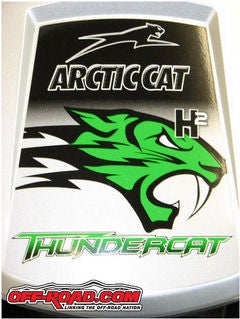
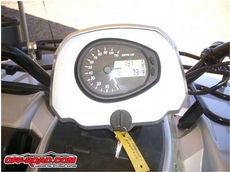
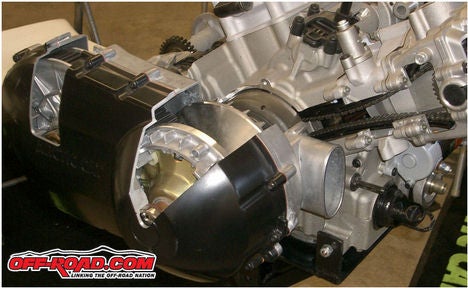
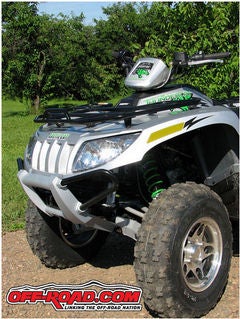
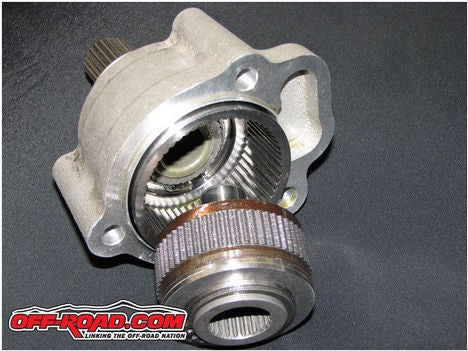
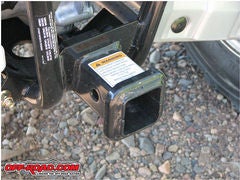

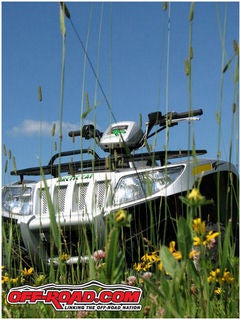

 Your Privacy Choices
Your Privacy Choices